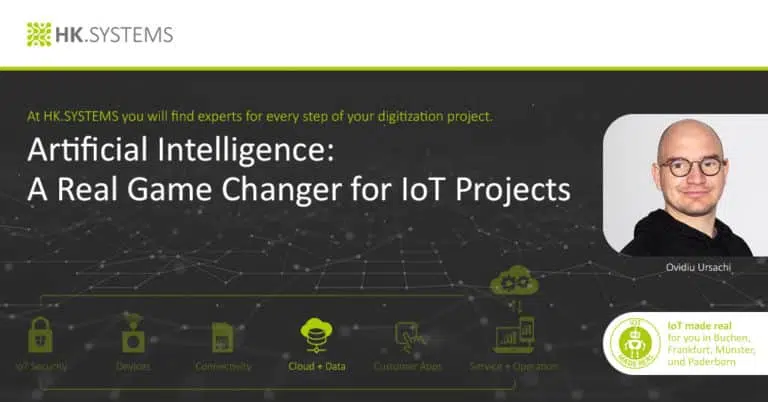Artificial intelligence (AI) and the Internet of Things (IoT): two technologies that are shaping ubiquitous digitalization. And which – when combined – can unleash a revolutionary force and become a real game changer for IoT projects.
The term AI describes special software that simulates intelligent behavior – for example, making independent decisions and solving problems in this way. The associated machine learning ensures that the AI can continue to learn from new, collected data and information. In this way, it improves its procedures and decision-making criteria virtually on its own – every second.
Ovidiu Ursachi is our HK.SYSTEMS expert in this field: “I’m a big fan of permanent learning; of constantly trying to find new ways of thinking up new solutions and things and networking them. The flexible use of the latest IoT technologies such as AI and machine learning plays a crucial role here: used correctly, they give us and our customers a significant edge over the competition.”
Artificial intelligence makes connected things really smart
The combination of the IoT and AI will make things really exciting in the future, because it will make networked devices, appliances and objects even more useful. Experts refer to this development as “Artificial Intelligence of Things” or “AIoT” for short: It combines the infrastructure of the Internet of Things, consisting of sensors, devices and data, with the advantages of artificial intelligence. A promising synthesis that can make applications even more efficient and sustainable. The expected benefits sound compelling:
- Predictive maintenance The basis is a well thought-out architecture and the intelligent use of machine learning algorithms: Both components specifically determine failure probabilities and generate reliable predictions. Expensive machine failures are avoided, maintenance costs are reduced in parallel.
- Optimization of the process chain Collecting large amounts of manufacturing-related data is the key to machine learning here. The use of AI optimizes the manufacturing process so that significantly less energy needs to be expended: A high savings potential for resources and costs.
- Optical defect detection The intelligent analysis of image material by AI technology: a perfect solution for the early detection of defects.
- Defect prediction AI applications such as the “digital twin” make it possible in the production environment to reliably predict surface damage. This know-how can be used to adjust system settings in real time. Damage thus does not occur in the first place.
- Sustainable planning of the process chain Cue micro-manufacturing in medical technology and the automotive industry: the so-called “miniaturization” of production systems and production processes increases functionality.
- IoT data-based product development & retrofit planning Future generations and retrofits of products are systematically improved by the insights gained from product usage and behavior data. This is not only about data-based identification of optimization potential, but also about targeted retrofit planning.
- Autonomous transport systems Efficient and automated transport systems lead to a wide range of improvements: Process optimization, flexibilization of production, reduction of waiting times and increase in productivity through the realization of smaller time intervals.
- Sustainability Analytics Machine learning and cloud technologies form an optimal combination for sustainable business and parallel competitive advantages: CO2 emission savings, lower costs and reliable risk predictions within the value chain.
Conclusion: Artificial intelligence – an indispensable indispensable component of successful IoT projects.
Vernetzte Dinge werden erst durch die Implementierung einer KI richtig smart. Sie werden zu smarten Devices, die aus ihrer eigenen Aktivität und voneinander lernen: Auf diese Weise entwickeln sie sich weiter und sind Networked things only become truly smart through the implementation of AI. They become smart devices that learn from their own activity and from each other: In this way, they develop further and are increasingly able to make their own decisions. Via artificial intelligence, networked devices are becoming increasingly autonomous and supplying more and more interpretable and usable data. This makes them increasingly valuable for companies of all sizes. Because they draw targeted consequences from the findings: They improve their products, optimize processes and thus secure their competitiveness on the global market in the long term.
In the future, AI and IoT will continue to grow together: Smart devices will become flexible – they will no longer function only in familiar structures, but will also be able to adapt to restructuring. Complete machine plants are transforming into multiply networked autonomous systems. Last but not least, the use of AI is also making interaction with machines more and more natural: intuitive human-machine communication and easy-to-use human-machine interfaces have long been part of this in various areas.
You want to start a digitization project with us? Feel free to contact us, we are looking forward to your project!: https://hk.digital/en/contact/
